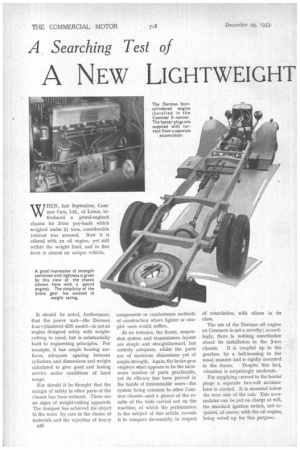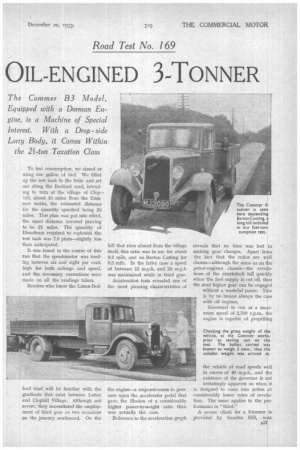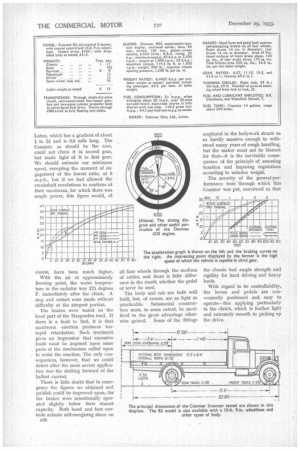A Searching Test of
Page 36

Page 37

Page 38

If you've noticed an error in this article please click here to report it so we can fix it.
A NEW LIGHTWEIGHT OIL-ENGINED 3-TONNER
The Commer B3 Model, Equipped with a Dorman Engine, is a Machine of Special Interest. With a Drop side Lorry Body, it Comes Within the 21-ton Taxation Class
WHEN, last September, Commer Cars, Ltd., of Luton, introduced a petrol-engined chassis for 3-ton pay-loads which weighed under 21 tons, considerable interest was aroused. Now it is offered with an oil engine, yet still within the weight limit, and in this form is almost an unique vehicle.
It should be noted, furthermore, that the power unit—the Dorman four-cylindered 4DS model—is not an engine designed solely with weightcutting in mind, but is substantially built to engineering principles. For example, it has ample bearing surfaces, adequate spacing between cylinders, and dimensions and weight calculated to give good and lasting service under conditions of hard usage.
Nor should it be thought that the margin of safety in other parts of the chassis has been reduced. There are no signs of weight-cutting apparent. The designer has achieved his object in the main by care in the choice of materials and the rejection of heavy 13.26 components or cumbersome methods of construction where lighter or simpler ones would suffice.
As an instance, the frame, suspension system and transmission layout are simple and straightforward, but entirely adequate, whilst the parts are of moderate dimensions yet of ample strength. Again, the brake gear employs vahat appears to be the minimum number of parts practicable, yet its efficacy has been proved in the hands of innumerable users—the system being common to other Commer chassis—and a glance at the results of the tests carried out on the machine, of which the performance is the subject of this article, reveals it to compare favourably, in respect of retardation, with others in its class.
The use of the Dorman oil engine on Commers is not a novelty ; accordingly, there is nothing unorthodox about its installation in the 3-ton chassis. It is coupled up to the gearbox by a bell-housing in the usual manner and is rigidly mounted in the frame. Despite this fact, vibration is surprisingly moderate.
For supplying current to the heater plugs a separate two-volt accumulator is carried. It is mounted below the near side of the cab. This accumulator can be put on charge at will, the standard ignition switch, not required, of course, with the oil engine, being wired up for this purpose. To test consumption, we aimed at using one gallon of fuel. We filled up the test tank to the brim and set out along the Bedford road, intending to turn at the village of Clophill, about 10 miles from the Corn. suer works, the estimated distance for the quantity specified being 20 miles. This plan was put into effect, the exact distance covered proving to be 21 miles. The quantity of Diesoleurn required to replenish the test tank was 7.8 pints—slightly less than anticipated.
It was found in the course of this run that the speedometer was reading between six and eight per cent. high for both mileage and speed, and the necessary corrections were made on all the readings taken.
Readers who know the Luton-Bed ford road will be familiar with the gradients that exist between Luton and Clophill Village. Although not severe, they necessitated the employment of third gear on two occasions on the journey southward. On the hill that rises almost from the village itself, this ratio was in use for about 0.1 mile, and on Barton Culling for 0.5 mile. In the latter case a speed of between 15 m.p.h. and 20 m.p.h was maintained while in third gear.
Acceleration tests revealed one of the most pleasing characteristics of the engine—a responsiveness to pressure upon the accelerator pedal that gave the illusion of a considerably higher power-to-weight ratio than was actually the case.
Reference to the acceleration graph reveals that no time was lost in making gear changes. Apart from the fact that the ratios are well chosen—although the same as on the petrol-engined chassis—the revolutions of the crankshaft fall quickly when the fuel supply is cut off, thus the next higher gear can be engaged without a wasteful pause. This is by no means always the case with oil engines.
Governed to run at a maximum speed of 2,500 r.p.m., the engine is capable of propelling the vehicle at road speeds well in excess of 40 m.p.h., and the existence of the governor is not irritatingly apparent as when it is designed to come into action at considerably lower rates of revolution. The same applies to the performance in "third."
A severe climb for a 3-tonner is provided by SundOn Hill, near B27 Luton, which has a gradient of about 1 in 51 and is 0.6 mile long. The Commer, as should be the case, could not climb it in second gear, but made light of it in first gear. We should estimate our minimum speed, excepting the moment of engagement of the lowest ratio, at 6 m.p.h., but if we had allowed the crankshaft revolutions to continue at their maximum, for which there was ample power, this figure would, of course, have been much higher.
With the air at approximately freezing point, the water temperature in the radiator was 175 degrees F. immediately after the climb. A stop and restart were made without difficulty at the steepest portion.
The brakes were tested on the level part of the Harpenden road. If there is a fault to find, it is that maximum exertion produces toorapid retardation. Such treatment gives an impression that excessive loads must be imposed upon some parts 01 the mechanism called upon to resist the reaction. The only consequences, however, that we could detect after the most severe application was the shifting forward of the ballast carried.
There is little doubt that in emergency the figures we obtained and publish could be improved upon.' for the brakes were intentionally operated slightly below their utmost capacity. Both hand and foot controls ,actuate self-energizing shoos on n2S all four wheels through the medium of cables, and there is little difference in the result, whether the pedal or lever be used.
The body and cab are both well built, but, of course, are as light a-s practicable. Substantial construction must, to some extent, be sacrificed to the great advantage otherwise gained. Some of the fittings employed in the bodywork struck us as hardly massive enough to withstand many years of rough handling, but the maker must not be blamed for that—it is the inevitable consequence of the principle of assessing taxation and imposing regulations according to unladen weight.
The severity of the general-performance tests through which this Coramer was put, convinced us that the chassis had ample strength and rigidity for hard driving and heavy loads.
With regard to its controllability, the levers and pedals are conveniently positioned and easy to operate—this applying particularly to the clutch, which is feather light and extremely smooth in picking up the drive.




















































































